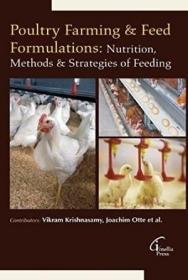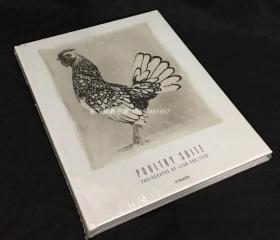
现货Poultry Farming & Feed Formulations: Nutrition , Methods & Strategies of Feeding[9781682511657]
¥ 4039 九五品
仅1件
作者Vikram samy, Joachim Otte
出版社Intelliz Press LLC
ISBN9781682511657
出版时间2016-01
装帧精装
纸张其他
正文语种英语
上书时间2023-08-08
- 最新上架
商品详情
- 品相描述:九五品
- 商品描述
- Poultry farming is the raising of domesticated birds such as chickens, ducks, turkeys and geese for the purpose of farming meat or eggs for food. Poultry are farmed in great numbers with chickens being the most numerous. Feed formulation is the process of quantifying the amounts of feed ingredients that need to be combined to form a single uniform mixture (diet) for poultry that supplies all of their nutrient requirements. Since feed accounts for 65-75% of total live production costs for most types of poultry throughout the world, a simple mistake in diet formulation can be extremely expensive for a poultry producer. Feed formulation requires thorough understanding of the: nutrient requirements of the class of poultry; feed ingredients in terms of nutrient composition and constraints in terms of nutrition and processing, and cost and availability of the ingredients. Feed formulation, often referred to as least cost formulation, is the process of matching the nutrient requirements of a class of animals with the nutrient contents of the available ingredients (raw materials) in an economic manner. Poultry Farming & Feed Formulations: Nutrition, Methods & Strategies of Feeding is intended to provide a framework on poultry framing and feeding methods and strategies. In first chapter, we estimate the volume of antibiotics used for swine and poultry production with the highest levels of production and consumption in China. Second chapter overviews on the basics of chicken farming. The aim of third chapter is a survey of biology and characteristics of artemia and possibility of its usage in poultry nutrition. The purpose of fourth chapter is to acquire information on the biosecurity procedures adopted by backyard poultry growers, the number and type of birds raised, and the husbandry practices; and to identify risk factors that are associated with infections in backyard poultry in rural China. Organic parasite control for poultry and rabbits is presented in fifth chapter. Sixth chapter indicates the need for continuous assessment of the mycological status of animal feed production, in order to feed animals for optimal performance ensuring food safety. Seventh chapter aims to review biomechanical issues related to feed behavior of domestic chickens to address some issues related to the feed used in commercial broiler chicken production, considering feed particle size, physical form and the impact of feeders during feeding. Eighth chapter provides a review on broiler’s welfare issues since its definition to several way of trying to assess it adequately. Ninth chapter describes the various essential growth promoters and novel feed supplements, their salient features, classical examples, bioactive principles, pharmacological and modes of action and useful applications for improving poultry production and health. The objective of tenth chapter is to identify the optimal concentration of Moringa oleifera leaves as a nutritional supplement for broilers and also to identify and evaluate the bioactive constituents of both the MO leaves and conventional feed and their impact on broiler meat antioxidant status. Last chapter presents on detection of quantitative trait loci (QTL) controlling feed efficiency and excretion in chickens fed a wheat-based diet.
相关推荐
-
![现货 British Poultry Standards[9781405156424]](https://www0.kfzimg.com/sw/kfz-cos/kfzimg/17733071/aaf7744f336ddc18_s.jpg)
现货 British Poultry Standards[9781405156424]
九五品上海
¥ 1237.00
-

现货 Jean Pagliuso: Poultry Suite
九五品北京
¥ 300.00
-

现货 Jean Pagliuso: Poultry Suite
九品北京
¥ 300.00
-
![现货Diseases of Poultry (Revised)[9780470958995]](https://www0.kfzimg.com/sw/kfz-cos/kfzimg/17733071/ed98a1b4d552efc8_s.jpg)
现货Diseases of Poultry (Revised)[9780470958995]
九五品上海
¥ 2067.00
-

GREEN MANURE IN RICE FARMIN G
九品濮阳市
¥ 176.80
-
![现货Poultry Production in the Tropics[9789715426312]](https://www0.kfzimg.com/sw/kfz-cos/kfzimg/17733071/231c942f2431525c_s.jpg)
现货Poultry Production in the Tropics[9789715426312]
九五品上海
¥ 228.00
-
![现货Poultry Science And Chicken Culture[9781781638514]](https://www0.kfzimg.com/sw/kfz-cos/kfzimg/17733071/10538739ebf3cc65_s.jpg)
现货Poultry Science And Chicken Culture[9781781638514]
九五品上海
¥ 1867.00
-
![现货Recent Developments in Poultry Nutrition[9781789222715]](https://www0.kfzimg.com/sw/kfz-cos/kfzimg/17733071/b778cc3a1689e9c1_s.jpg)
现货Recent Developments in Poultry Nutrition[9781789222715]
九五品上海
¥ 1594.00
-
![现货Illustrated Handbook of Poultry Farming[9781680946642]](https://www0.kfzimg.com/sw/kfz-cos/kfzimg/17733071/9586af9a785f103f_s.jpg)
现货Illustrated Handbook of Poultry Farming[9781680946642]
九五品上海
¥ 4059.00
-
![现货Poultry: Biology, Breeds And Breeding[9781781638521]](https://www0.kfzimg.com/sw/kfz-cos/kfzimg/17733071/3d80b5d82d6701dd_s.jpg)
现货Poultry: Biology, Breeds And Breeding[9781781638521]
九五品上海
¥ 1867.00
— 没有更多了 —
![现货Poultry Farming & Feed Formulations: Nutrition , Methods & Strategies of Feeding[9781682511657]](https://www0.kfzimg.com/sw/kfz-cos/kfzimg/17733071/cf1502a4e96be357_b.jpg)

![Petrucci's General Chemistry: Principles and Modern Applications [9781292726137]](https://www0.kfzimg.com/sw/kfz-cos/kfzimg/17733071/f3b0e1ed1b0ac6e4_s.jpg)
![现货Materials and Technologies of Modern Production[9783036401683]](https://www0.kfzimg.com/sw/kfz-cos/kfzimg/17733071/5fd2824531e165d7_s.jpg)
![现货Introduction to Container Ship Operations and Onboard Safety[9781032155425]](https://www0.kfzimg.com/sw/kfz-cos/kfzimg/17733071/58b7ff43ef7909ee_s.jpg)
![现货Electrophosphorescent Materials and Devices[9789814877343]](https://www0.kfzimg.com/sw/kfz-cos/kfzimg/17733071/18cc1d77bcb7b488_s.jpg)
![现货Organic Semiconductors for Optoelectronics[9781119146100]](https://www0.kfzimg.com/sw/kfz-cos/kfzimg/17733071/24c85a750c708964_s.jpg)
![现货Advances in Food Rheology and Its Applications[9780081004319]](https://www0.kfzimg.com/sw/kfz-cos/kfzimg/17733071/e0c11603c9119d4d_s.jpg)
![现货Advanced Materials and Sustainable Technologies[9783035727562]](https://www0.kfzimg.com/sw/kfz-cos/kfzimg/17733071/dced675333874c48_s.jpg)
![现货Advanced Materials and Manufacturing Engineering II[9783035712681]](https://www0.kfzimg.com/sw/kfz-cos/kfzimg/17733071/660ccfae75fa8d3e_s.jpg)
![现货Materials in Machinery and Construction[9783035718119]](https://www0.kfzimg.com/sw/kfz-cos/kfzimg/17733071/6f402060775e9daa_s.jpg)
![现货Poultry Farming & Feed Formulations: Nutrition , Methods & Strategies of Feeding[9781682511657]](/dist/img/error.jpg)
以下为对购买帮助不大的评价